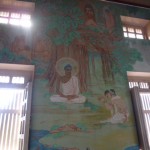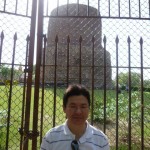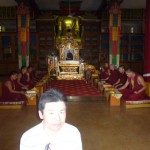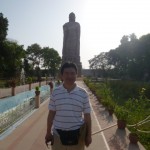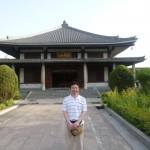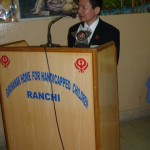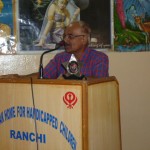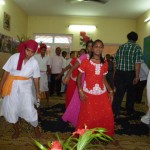インド訪問記
長崎県立こども医療福祉センター
松林 昌平
2011年後期Murakami-Sano-Sakamaki Asia Visiting Fellowshipに選任され、2012年4月8日から20日までインドのRanchiを訪問しましたので、ご報告します。
Ranchi はJharkhand州の州都で、Kolkataから飛行機で西へ1時間程の所です。暑いインドの中でもRanchiは高原にあるので過ごしやすく、17 世紀ぐらいまではジャングルに覆われていて象や虎も住んでいたそうです。人口は約110万人です。ちなみにインドでは百万都市が39個もあります。
Ranchi にはKolkata経由で入りました。Kolkataには夜中の11時に到着しました。空港の両替所で両替をしましたが、日本円は駄目と言われ、念のため 持って来た米ドルをインドルピーに交換しました。インドではルピーの国外持ち出しが禁止されていてインドでしか入手できません。プリペイドタクシーに乗っ てホテルに向かいましたが、チップの請求がしつこくて恐いです。日本円やシンガポールドルを要求されましたが、100ルピーを渡して開放されました。
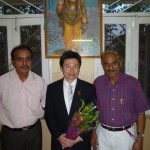 Ranchi 空港には今回のfellowshipを全面的に支援してくれたDr Anil Kumar Pandeyが出迎えてくれました。この方はYamamuro-Ogiwara Internatinal Travelling Fellowとして神奈川県立こども医療センターで一年間研修されたことがあり、流暢な日本語を話されます。日本滞在中は亀下先生夫妻にお世話になったそ うで、二人を両親のように慕っていました。インドの小児整形外科学会においてDr Kameshita young surgen’s Forum Prizeを作ったそうです。
Ranchi 空港には今回のfellowshipを全面的に支援してくれたDr Anil Kumar Pandeyが出迎えてくれました。この方はYamamuro-Ogiwara Internatinal Travelling Fellowとして神奈川県立こども医療センターで一年間研修されたことがあり、流暢な日本語を話されます。日本滞在中は亀下先生夫妻にお世話になったそ うで、二人を両親のように慕っていました。インドの小児整形外科学会においてDr Kameshita young surgen’s Forum Prizeを作ったそうです。
父のDr Soreshwar PandeyはThe Journal of Foot and Ankle SurgeryのEditorをされています。親日家で今まで日本を9回訪れたそうで、長崎大学の鈴木良平教授とも親交があったそうです(図1)。
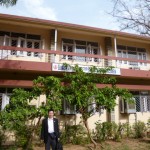 滞在したGuru Nanak Home For Handicapped Children Hospital(図2)は父のDr S Pandeyが貧しい子供達の為に設立した病院で、治療費は無料です。
滞在したGuru Nanak Home For Handicapped Children Hospital(図2)は父のDr S Pandeyが貧しい子供達の為に設立した病院で、治療費は無料です。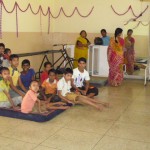 経営は寄付によって成り立っています。そのためプレート等高価な道具は使わずに、お 金がかからない治療で良い結果が得られるように心がけています。ベッドは70床。医者はDr Pandey親子のみです。二人とも無償で働いています。給料は自分の病院であるRJSIOR Hospitalで稼ぐとのことでした。部屋はすべて大部屋で、リハビリは一室に集められて一緒にしていました(図3)。
経営は寄付によって成り立っています。そのためプレート等高価な道具は使わずに、お 金がかからない治療で良い結果が得られるように心がけています。ベッドは70床。医者はDr Pandey親子のみです。二人とも無償で働いています。給料は自分の病院であるRJSIOR Hospitalで稼ぐとのことでした。部屋はすべて大部屋で、リハビリは一室に集められて一緒にしていました(図3)。
手術はほとんどの症例で手洗いさせてもらいました。私の為に22例の手術を用意してくれました。疾患は脳性麻痺、ポリオ、myopathy、内反足が多かったです。
脳性麻痺のはさみ脚には長内転筋・薄筋を全切離し、閉鎖神経を切離します。尖足に対しては腓腹筋の延長(Vulpius法)をしていましたが、一ヵ所の延長で背屈30°までいくのは不思議でした。やはり術中に筋肉の延長量をコントロールするのは難しいと考えました。
ポリオに対しては三関節固定のPandey Modified Lambrinudi’s triple arthrodesisが多かったです。距骨頭から頚部の下2/5を切除するのでpronationさせると舟状骨がきれいに整復されます。また短腓骨筋 腱を長母趾伸筋に移行して母趾をやや背屈させるのが特徴です。
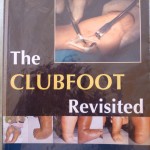 今回内反足に関してはDr Pandey親子の著書である「The CLUBFOOT Revisited」という本(図4)を頂いて勉強しました。インド整形外科学会でのbest publicationに選ばれたそうです。内反足の歴史、成因、治療法(ギプスから骨切りまで)等、多岐にわたって書かれており、確かに良い本です。ま た彼らはインドの整形外科医向けにPonseti法の本も書いていて、Ponseti法を完全に理解した上で他の方法を採用していました。
今回内反足に関してはDr Pandey親子の著書である「The CLUBFOOT Revisited」という本(図4)を頂いて勉強しました。インド整形外科学会でのbest publicationに選ばれたそうです。内反足の歴史、成因、治療法(ギプスから骨切りまで)等、多岐にわたって書かれており、確かに良い本です。ま た彼らはインドの整形外科医向けにPonseti法の本も書いていて、Ponseti法を完全に理解した上で他の方法を採用していました。
生後すぐに矯正を始めたら、腱切りはせずにギプスのみ。生後2ヶ月を過ぎたらMinimally Invasive Cast Correction of Clubfoot (MICC)。足底腱膜とアキレス腱を経皮的に切って一期矯正します。外転、少しpronation、足趾の色を見ながら背屈します。2~3週毎にギプス を巻き変えて3回程のギプスできれいに整復されます。1歳以降にはSoft Tissue Release in Clubfoot through Double Incision of Pandey(図5※施術画像)。後内側解離ですがアキレス腱に沿った皮切と内側の皮切と二つに分ける事によって、足関節後方が見えやすくなるのではないかと考えま した。また内側から踵立方関節がきれいに見えるのは驚きでした。今回は見られませんでしたが、成人の放置例に対しては骨切りをしていました。
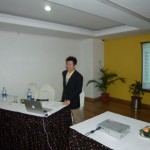 Capital Hill HotelにてRanchiの整形外科医を対象に講演する機会をいただきました。第22回日本小児整形学会で発表した「Indication of soft-tissue release for spastic hip in cerebral palsy」、第91回長崎整形外科懇話会で発表した「Deformity correction using external fixator」、長崎の歴史についてまとめた「Introduction of Nagasaki」の三つを発表しました(図6)。質問が二つぐらいありましたが(図7)、褒められたのは長崎の観光スライドぐらいでした。記念品に頂い たガネーシャの置物が傷心の私を慰めてくれました(図8)。
Capital Hill HotelにてRanchiの整形外科医を対象に講演する機会をいただきました。第22回日本小児整形学会で発表した「Indication of soft-tissue release for spastic hip in cerebral palsy」、第91回長崎整形外科懇話会で発表した「Deformity correction using external fixator」、長崎の歴史についてまとめた「Introduction of Nagasaki」の三つを発表しました(図6)。質問が二つぐらいありましたが(図7)、褒められたのは長崎の観光スライドぐらいでした。記念品に頂い たガネーシャの置物が傷心の私を慰めてくれました(図8)。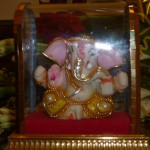
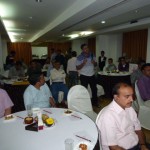 Dr A.K Pandeyにインドの整形外科医は脳性麻痺に興味は無いのか?と聞いたところ、インドではポリオの治療が主だそうです。また脳性麻痺患者はお金持ちであ れば大都会で治療を受けて、Ranchiとか田舎では貧しい脳性麻痺患者が治療を受けるそうです。それも治療しているのは無料のGuru Nanak Home For Handicapped Children Hospitalぐらいで、脳性麻痺を診る整形外科医はあまりいないそうです。また整形外科医もお金を稼ぐなら、外傷を診るそうです。
Dr A.K Pandeyにインドの整形外科医は脳性麻痺に興味は無いのか?と聞いたところ、インドではポリオの治療が主だそうです。また脳性麻痺患者はお金持ちであ れば大都会で治療を受けて、Ranchiとか田舎では貧しい脳性麻痺患者が治療を受けるそうです。それも治療しているのは無料のGuru Nanak Home For Handicapped Children Hospitalぐらいで、脳性麻痺を診る整形外科医はあまりいないそうです。また整形外科医もお金を稼ぐなら、外傷を診るそうです。
寝台列車に乗ってバナーラスに行くこともできました(図9,10)。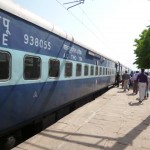 14時間かかりました。列車の中でDr A.K Pandeyと色々な話をしました。1995年にGuru Nanak Home For Handicapped Children Hospitalを設立した時は、患者が集まらなかったそうです。そこで色々な所を回って患者を集めました。今までに110の医療キャンプを行ったそうで す。患者は障害の事を神が与えた贈り物と考えています。
14時間かかりました。列車の中でDr A.K Pandeyと色々な話をしました。1995年にGuru Nanak Home For Handicapped Children Hospitalを設立した時は、患者が集まらなかったそうです。そこで色々な所を回って患者を集めました。今までに110の医療キャンプを行ったそうで す。患者は障害の事を神が与えた贈り物と考えています。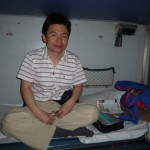 そこで障害は治せると説明し、術前後の写真を見せて説得したそうです。最初はポケットマネーで患者 を病院に連れて来たそうです。それで今では自然に患者が集まるようになったとの事でした。今まで1万例以上の手術を行い、今年の2月だけで65例の手術を したそうです。また毎年日本からのfellowshipを受け入れたいとの事でした。今回は初めてだったけど、徐々に改善していくから是非来てくれとの事 でした。とてもありがたいことです。インドを訪れるなら、ベストシーズンは11月から2月だそうです。
そこで障害は治せると説明し、術前後の写真を見せて説得したそうです。最初はポケットマネーで患者 を病院に連れて来たそうです。それで今では自然に患者が集まるようになったとの事でした。今まで1万例以上の手術を行い、今年の2月だけで65例の手術を したそうです。また毎年日本からのfellowshipを受け入れたいとの事でした。今回は初めてだったけど、徐々に改善していくから是非来てくれとの事 でした。とてもありがたいことです。インドを訪れるなら、ベストシーズンは11月から2月だそうです。
バナーラス(図11)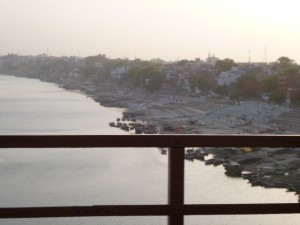 は聖なるガンジス川のほとりにあり、3000年以上の歴史を持つヒンドゥー教最大の聖地です。そこではKiran Center for Education & Rehabilitation of Children(図12)を訪れました。寄付で成り立っている施設で、障害がある子供も無い子供も教育を受けられます(図13)。低いカーストの人々に も教育や職業訓練を行い、経済的に自立できるようにするそうです。施設の理学療法士達はそれぞれ担当地域を回って、患者を見つけて連れて来ます。今回も Dr A.K Pandeyの診察目的に新患や術後の患者が20人程集められていました。そのほとんどがポリオの患者でした。
は聖なるガンジス川のほとりにあり、3000年以上の歴史を持つヒンドゥー教最大の聖地です。そこではKiran Center for Education & Rehabilitation of Children(図12)を訪れました。寄付で成り立っている施設で、障害がある子供も無い子供も教育を受けられます(図13)。低いカーストの人々に も教育や職業訓練を行い、経済的に自立できるようにするそうです。施設の理学療法士達はそれぞれ担当地域を回って、患者を見つけて連れて来ます。今回も Dr A.K Pandeyの診察目的に新患や術後の患者が20人程集められていました。そのほとんどがポリオの患者でした。
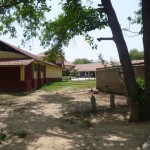
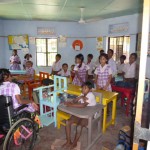
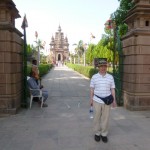 観光にはバナーラスから車で30分程のサールナートに行きました。ここはブッダが初めて説法をした(初転法輪の地)であり、仏教徒にとって重要な聖地です。 ムールガンダ・クティー寺院(図14)にはブッダの生涯を描いた壁画(図15)があります。戦前の日本人画家、野生司香雪(のうすこうせつ)の作品です。
観光にはバナーラスから車で30分程のサールナートに行きました。ここはブッダが初めて説法をした(初転法輪の地)であり、仏教徒にとって重要な聖地です。 ムールガンダ・クティー寺院(図14)にはブッダの生涯を描いた壁画(図15)があります。戦前の日本人画家、野生司香雪(のうすこうせつ)の作品です。
ダメーク・ストゥーパ(仏塔)(図16)は外から見学しました。色彩豊かなチベット僧院にはダライ・ラマの写真がありました(図17)。外の看板には中国 によるチベット侵略の記載がありました。中国寺は台湾寄贈のお寺です。タイ寺院には巨大なブッダの像(図18)がありました。最後に日本寺の日月山法輪寺 (図19)を訪れました。
インドの食事はもちろんカレーでした。すべての食事の味付けがカレー味です。一度は甘いジュースと思って飲んだら、カレー味のジュースで大変驚きました。ま た感染症も心配ですが、私も滞在三日目にして洗礼を浴びました。吐き気、腹痛、発熱、関節痛に襲われ、感染性腸炎になりました。絶食、W.H.O推薦のイオン飲料摂取、点滴にて一日で治しました。食事を取れるようになってからはヨーグルトの大量摂取で何とか乗り切りました。さすがにヨーグルトはカレー味で はなかったです。
インドのトイレ事情ですが、ホテルにはお尻洗浄用のシャワーが備わっていました。使用したらお尻全体が濡れてしまいます。ホテルのトイレは贅沢な方で、基本的には紙が無く、水の入った手桶があるのみです。一度挑戦してみましたが、ビショビショになりました。
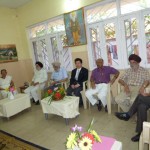 最終日にはGuru Nanak Home For Handicapped Children Hospitalで私の為にお別れ会を開いてくれました(図20)。
最終日にはGuru Nanak Home For Handicapped Children Hospitalで私の為にお別れ会を開いてくれました(図20)。
子供達による歌や踊りが催されました(図21)。
Dr S Pandeyのスピーチでは、彼のこの病院に対する思いが伝わって来ました(図22)。私も御礼のスピーチをしました(図23)。
今回のインド訪問では、短期間の内に日本では見られない症例をたくさん経験できて、とても勉強になりました。私が感じたことは日本小児整形外科学会及び先人 達がアジアの医療に貢献してきたこと。その恩恵を私が受ける事ができたこと。私もまたfellowshipの受け入れ先として選ばれるようになりたいとい うことです。
最後にこのような機会を与えてくださいました清水克時理事長、川端秀彦国際委員会委員長をはじめとする日本小児整形外科学会の会員、関係者の皆様に心より御礼申し上げます。
A report of India as the Murakami-Sano-Sakamaki Asia Visiting Fellow in the second half of the year 2011
Nagasaki Prefectural Center of Medicine and Welfare for Children
Shohei Matsubayashi
I was selected as a Murakami-Sano-Sakamaki Asia Visiting Fellow in the second half of the year 2011 and visited Ranchi in India from April 8 to 20, 2012.
Ranchi is the capital of the Indian state of Jharkhand and located west of Kolkata. It takes about 1 hour from Kolkata to Ranchi by airplane. Although it is hot in India, Ranchi is situated on a plateau and has relatively comfortable climate. I heard that this city had been covered with a jungle until the 17th century, and elephants and tigers had lived there. The population is about 1,100,000. There are 39 cities in India with populations over 1 million.
I arrived at Ranchi via Kolkata. In the Ranchi airport, I met Dr. Anil Kumar Pandey, who was a local host of this fellowship. He spent 1 year in Kanagawa Children’s Medical Center as a Yamamuro-Ogiwara International Travelling Fellow and spoke Japanese fluently. During his stay in Japan, he was very much helped by Dr. Kameshita and his wife. He had a great affection for them as if they had been his parents, and founded the Dr. Kameshita Young Surgeon’s Forum Prize in the Pediatric and Orthopaedic Society of India. Dr. Sureshwar Pandey, his father, is the Editor of the Journal of Foot and Ankle Surgery. He is a Japanophile, and has visited Japan 9 times so for, and was on friendly terms with Prof. Ryohei Suzuki of Nagasaki University.
The Guru Nanak Home for Handicapped Children Hospital for poor children where I studied,was established by Dr. S. Pandey, . Treatment is free of charge and, this hospital is run on donations. Therefore, expensive instruments such as plates are not used, and staffs make efforts to achieve good results using inexpensive materials. There are 70 beds and only 2 physicians, i.e., Dr. S. Pandey and his son. They work for free, saying that they earn their salaries in RHSIO Hospital as their own hospital. All patient shared large rooms, and patients receive rehabilitation together in one room.
I scrubed for many cases as 22 surgical cases were prepared for me. Cerebral palsy, polio, myopathy, and clubfoot were frequently observed.
For scissoring posture due to cerebral palsy, the long adductor and gracilis muscles were transected, and the obturator muscles were cut. For equinus foot, gastrocnemius lengthening was performed. I thought that the control of the amount of muscle lengthening during the operation is difficult. For polio, Pandey’s modified Lambrinudi’s triple arthrodesis was frequently performed. Since the area from the head of the talus to 2/5 of the neck is resected, the navicular is correctly reduced in pronation. The other characteristic of this technique is slight dorsiflexion of the hallux by transferring the peroneus brevis tendon to the extensor hallucis longus tendon.
I was given “The CLUBFOOT Revisited” written by Dr. S. Pandey and his son. It is honored the best publication award from the Pediatric and Orthopaedic Society of India. This book is a valuable book dealing with various aspects of clubfoot such as its history, pathogenesis, and treatment methods (from casting to osteotomy). They also wrote a book about Ponseti’s method for orthopedic surgeons in India.
I was given an opportunity to give a lecture to orthopedic surgeons in Ranchi in Capital Hill Hotel. I reported “Indication of soft-tissue release for spastic hip in cerebral palsy” formerly presented at the 22nd conference of the Japanese Pediatric Orthopedic Association, “Deformity correction using external fixator” presented at the 91st meeting of the Nagasaki Orthopedic Surgery Association, and “Introduction of Nagasaki. As a memorial gift, a Ganesha statue ornament was presented to me. When I asked Dr. A.K. Pandey whether or not orthopedic surgeons in India are interested in cerebral palsy, he answered that treatment for polio is major concern in India. If treatment for cerebral palsy is provided only in the Guru Nanak Home for Handicapped Children Hospital, and there are few orthopedic surgeons who treat cerebral palsy. Orthopedic surgeons who want to earn much money treat patients with trauma.
I went to Banaras on an overnight train. It took about 14 hours. On the train, I talked with Dr. A. K. Pandey about various topics. When the Guru Nanak Home for Handicapped Children Hospital was established in 1995, only a few patients came. Therefore, they recruited patients by visiting various places. He has visited 110 medical camps to the present. Patients consider that even their disabilities are presented by the God. Therefore, he had to explain that disabilities can be improved, and persuaded them to undergo treatment, showing photos before and after treatment. At first, he brought patients to the hospital using his own money. But now many patients are visiting his hospital. He has performed surgery in more than 10,000 cases, and performed surgery in 65 cases in February of this year. He is willing to receive visiting fellows from Japan. He said to me, “This is the first fellowship program, but as we will gradually improve this fellowship, please encourage young Japanese doctors to visit our hospital.” I am grateful to him for his kindness. Banaras is the greatest holy place of Hinduism situated on the banks of the Ganges river. In Banaras, I visited Kiran Center for Education & Rehabilitation of Children. This center is run on donations, and provides education to both children with and without disabilities. Education and occupational training are also given to low-caste people to achieve economic independence. Physical therapists in this center visit areas they are responsible for, and find and bring patients to the center. When I visited this center, there were about 20 patients (new or postoperative patients) brought to the center for treatment by Dr. A. K. Pandey. Most patients had suffered polio.
I visited Sarnath. It took about 30 minutes by car. This is the site of Buddha’s first teachings and a holy place for Buddhists. In Mulagandhakuti Vihara, there were mural paintings of Buddha’s life. These paintings are works by Kosetsu Nousu, a prewar Japanese artist. I viewed Dhamekh Stúpa (pagoda) from the outside. In the Tibetan monastery with rich colors, there was a photo of the Dalai Lama. There was a signboard outside the monastery showing a description of Tibet’s invasion by China. The Chinese temple was contributed by Taiwan. In the Thai temple, there was a huge statue of Buddha. Finally, I visited Nichigetusan Horinji, a Japanese temple.
On the last day, they held a farewell party for me in the Guru Nanak Home for Handicapped Children Hospital. Children sang songs and danced. Dr. S. Pandey’s speech revealed his feelings toward his hospital. I also gave a speech of appreciation.
During my short visit to India, I encountered many cases that cannot be observed in Japan. I felt that the Japanese Pediatric Orthopedic Association and predecessors have made a great contribution to medicine in Asia, and, therefore, I could receive this benefit. I express my deep gratitude to the Chief Director Katsuji Shimizu, Chairman of the International Committee Hidehiko Kawabata, other members of the Japanese Pediatric Orthopedic Association, and persons giving me such a wonderful opportunity.




